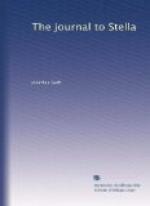18. Ann Long was sister to Sir James Long, and niece to Colonel Strangeways. Once a beauty and toast of the Kit-Cat Club, she fell into narrow circumstances through imprudence and the unkindness of her friends, and retired under the name of Mrs. Smythe to Lynn, in Norfolk, where she died in 1711 (see Journal, December 25, 1711). Swift said, “She was the most beautiful person of the age she lived in; of great honour and virtue, infinite sweetness and generosity of temper, and true good sense” (Forster’s Swift, 229). In a letter of December 1711, Swift wrote that she “had every valuable quality of body and mind that could make a lady loved and esteemed.”
19. Said, I know not on what authority, to be Swift’s friend, Mrs. Barton. But Mrs. Barton is often mentioned by Swift as living in London in 1710-11.
20. One of Swift’s cousins, who was separated from her husband, a man of bad character, living abroad. Her second husband, Lancelot, a servant of Lord Sussex, lived in New Bond Street, and there Swift lodged in 1727.
21. 100,000 pounds.
22. Francis Stratford’s name appears in the Dublin University Register for 1686 immediately before Swift’s. Budgell is believed to have referred to the friendship of Swift and Stratford in the Spectator, No. 353, where he describes two schoolfellows, and says that the man of genius was buried in a country parsonage of 160 pounds a year, while his friend, with the bare abilities of a common scrivener, had gained an estate of above 100,000 pounds.
23. William Cowper, afterwards Lord Cowper.
24. Sir Simon Harcourt, afterwards Viscount Harcourt, had been counsel for Sacheverell. On Sept. 19, 171O, he was appointed Attorney-General, and on October 19 Lord Keeper of the Great Seal. In April 1713 he became Lord Chancellor.
25. This may be some relative of Dr. John Freind (see Letter 9), or, more probably, as Sir Henry Craik suggests, a misprint for Colonel Frowde, Addison’s friend (see Journal, Nov. 4, 171O). No officer named Freind or Friend is mentioned in Dalton’s English Army Lists.
26. See the Tatler, Nos. 124, 2O3. There are various allusions in the “Wentworth Papers” to this, the first State Lottery of 171O; and two bluecoat boys drawing out the tickets, and showing their hands to the crowd, as Swift describes them, are shown in a reproduction of a picture in a contemporary pamphlet given in Ashton’s Social Life in the Reign of Queen Anne, i. 115.
27. A few weeks later Swift wrote, “I took a fancy of resolving to grow mad for it, but now it is off.”
28. Sir John Holland, Bart., was a leading manager for the Commons in the impeachment of Sacheverell. He succeeded Sir Thomas Felton in the Comptrollership in March 171O.
29. Dryden Leach. (see Letter 7.)
30. William Pate, “bel esprit and woollen-draper,” as Swift called him, lived opposite the Royal Exchange. He was Sheriff of London in 1734, and died in 1746. Arbuthnot, previous to matriculating at Oxford, lodged with Pate, who gave him a letter of introduction to Dr. Charlett, Master of University College; and Pate is supposed to have been the woollen-draper, “remarkable for his learning and good-nature,” who is mentioned by Steele in the Guardian, No. 141.




